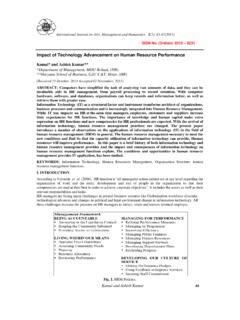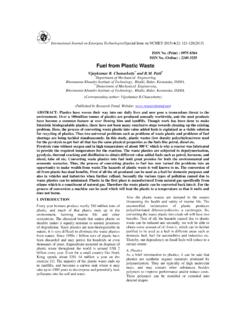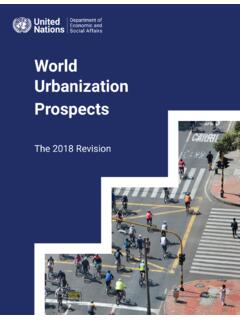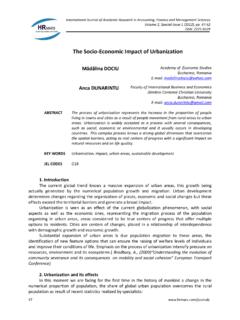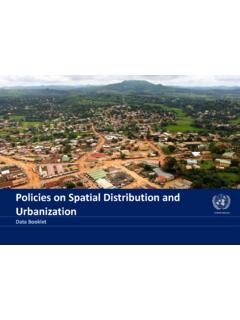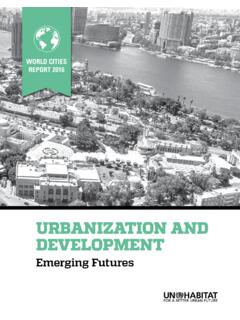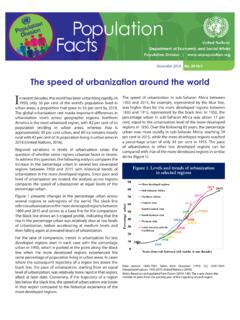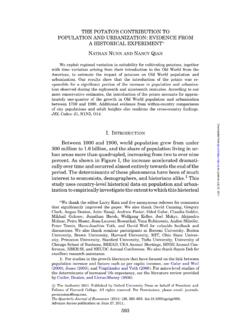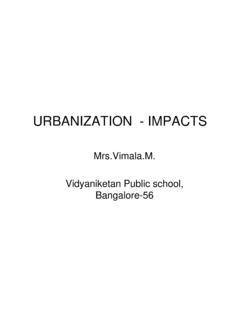Transcription of Impact of Urbanization on Environment
1 International Journal on Emerging Technologies 8(1): 127-129(2017) ISSN No. (Print) : 0975-8364 ISSN No. (Online) : 2249-3255 Impact of Urbanization on Environment Mohit Singh Rai Student of B. Tech Urban and Regional Planning 5th Sem, Guru Ram Das School of Planning, Guru Nanak Dev University, Amritsar, (Punjab), INDIA (Corresponding author: Mohit Singh Rai) (Received 26 December, 2016 accepted 15 January, 2017) (Published by Research Trend, Website: ) ABSTRACT: Urbanization refers to general increase in population and the amount of industrialization of a settlement.
2 It symbolizes the movement of people from rural to urban areas. Urbanization happens because of the increase in the extent and density of urban areas. Due to uncontrolled Urbanization in India, environmental degradation has been occurring very rapidly and causing many problems like land insecurity, worsening water quality, excessive air pollution, noise and the problems of waste disposal. This paper emphasizes on the effect of Urbanization on environmental components mainly public health and habitat, climate, biosphere, land and water resources. A case study of Urbanization in India has been carried out leading to conclude on the existing causes of damage to the Environment due to Urbanization . Although it is impossible to restrict Urbanization it has to be ensured that Urbanization proceeds in the right path causing minimum Impact on Environment .
3 I. INTRODUCTION Although India is one of the less urbanized countries of the world with only percent of population living in towns, India is facing a serious crisis of urban growth at present time whereas Urbanization has been an instrument of economic, social and political progress, it has led to serious socio-economic problems. Urbanization is a process that leads to the growth of cities due to industrialization and economic development . The population is growing at the rate of about 17 million annually which mean a staggering 45,000birth per day and 31 births per minute. If the current trend continues by the year 2050, India would have 1620 million populations. Due to controlled Urbanization in India, environmental degradation has been occurring very rapidly and causing many problems like shortage of houses, water quality, excessive air pollution, noise, dust and heat, problems of disposal of wastes, etc.
4 Which causes serious health problems. II. REASONS OF Urbanization As per data available, about 50% of total world population is residing in urban areas in the beginning of 21st Century. The increasing trend of urban population is due to: Better employment facilities, medical facilities, Better facilities for trade and commerce, Better facilities for higher education, Facilities for entertainment, sports & games, Proximity to administration and important government offices. Due to these reasons, such an increase in urban population induces a lumber of environmental problems. III. MAJOR PROBLEMS OF Urbanization IN INDIA Fig. 1. Major Problems of Urbanization . et Rai 128 IV.
5 IMPACTS OF URBANISATION ON Environment The sheer magnitude of the urban population, haphazard and unplanned growth of urban areas, and a desperate lack of infrastructure are the main causes of such a situation. The rapid growth of urban population both natural and through migration, has put heavy pressure on public utilities like housing, sanitation, transport, water, housing, sanitation, transport, water, electricity, health, education, and so on. Poverty, unemployment and under employment among the rural immigrants, beggary, thefts, dacoities, burglaries and other social evils are on rampage. Urban sprawl is rapidly encroaching the precious agricultural land. The population of India had already crossed the 285 million mark by 2001.
6 By 2030, more than 50 percent of India s population is expected to live in poor Environment . The Impact of all this growth on space, Environment and quality of life will be, to say the least, tremendous. The provision of infrastructural facilities required to support such large concentration of population is lagging far behind the pace of Urbanization . As a consequence, the urban Environment , particularly in large cities, is deteriorating very rapidly. Some important environmental problems are discussed below: A. Over Exploitation of Natural Resources Due to high population density and expensive life style, the rate of consumption of natural resources ( water, energy, fossil fuel, forest products etc.) is very high in urban areas.
7 There is also misuse of natural resources whose immediate compensation becomes difficult. Few acute problems of urban areas are scarcity of drinking water especially the ground water, scarcity of forest products, power cut due to excessive use of electricity etc. B. Air Pollution The air of urban areas get polluted due to a lot of anthropogenic activities, flying of large number of automobiles, industries etc. These activities release pollutants like carbon monoxide, carbon dioxide, oxides of nitrogen, oxides of sulphur, hydrocarbons, vapours of organic compounds, particulates, and toxic metals etc. which are capable of including a number of health hazards. C. Noise Pollution The noise produced from automobiles, vehicles, social functions, industries etc.
8 Cause noise pollution in urban areas which causes psychological and physical ailments. D. Unusual Rise in Temperature The unplanned construction of large buildings in urban areas absorbs solar radiation and in the afternoon, these emit heat radiations increasing the climatic pressure. As a result year 2015 was the hottest year from last years. Cities often receive more rain than the surrounding countryside since dust can provoke the condensation of water vapor into rain droplets. E. Management of Solid Waste Thickly populated urban area consumes large quantities of material and simultaneously releases a lot of solid wastes. The solid wastes include municipal wastes, industrial wastes, hazardous wastes etc. The solid waste production increases with an increase in population foul smell and poisonous gases and become breeding grand s of vectors of different diseases.
9 The gases produced cause air pollution, surface run-off from the wastes causes water pollution and vector causes different diseases. F. development of Slums The areas within the cities and towns without civic and basic amenities are called Slums. The slum settlement arises due to un-flux of rural peoples into urban areas and shortage of housing facilities for them. They construct their dwellings using rusted tins, empty tar barrels, jute sacks, etc. Although these areas become overcrowded, these lack civic amenities like light, water supply, drainage, roads, toilets and medical facilities. The areas of slums become centers of a number of environmental problems. Some important problems may be outlined as follows: (i) These areas without proper water supply dispose their waste in an unplanned manner which pollutes air and water.
10 (ii) The contamination of water causes diseases like typhoid, cholera, enteric fever, etc. (iii) The unplanned waste dumping places and open defecation become the sites of the growth of a number of disease carriers like flies, mosquitoes, etc. These cause health hazards not only in slum areas but also in other nearby places. V. Urbanization IN INDIA The pattern and trend of urban population and number of towns in India during 1901 to 2001 shows that total urban population has increased more than ten times from 26 million to 285 million, whereas total population has increased less than five times from 238 million to 1027 million from 1901 to 2001. (Table 1). Rai 129 Table 1: Pattern and Trend of Urbanization in India, 1901 2001.


